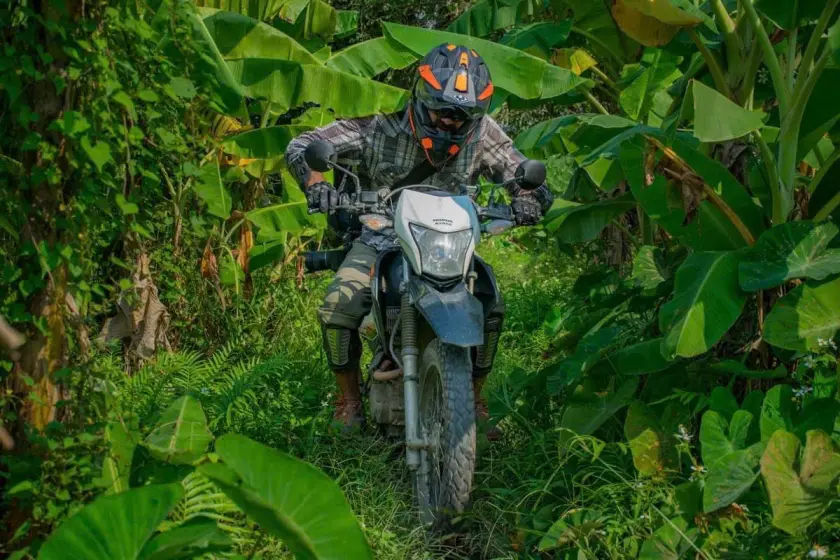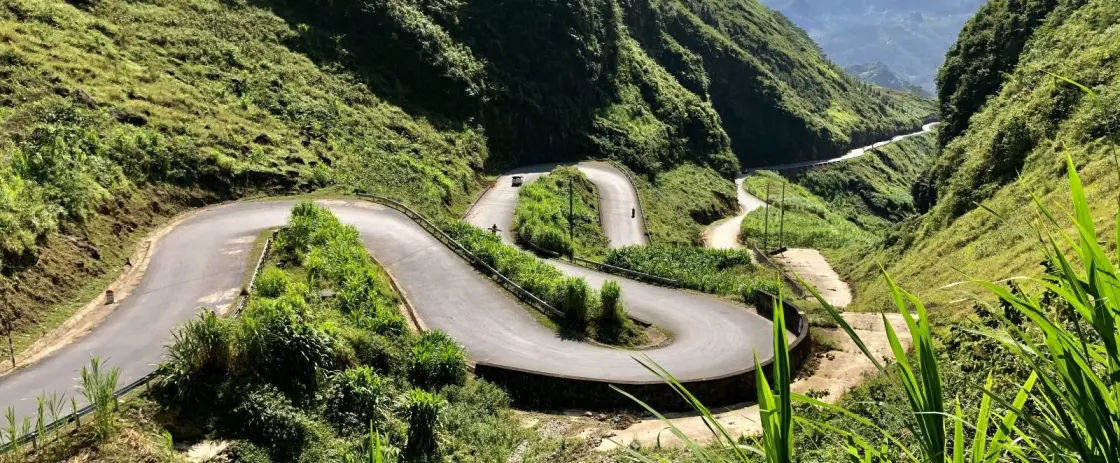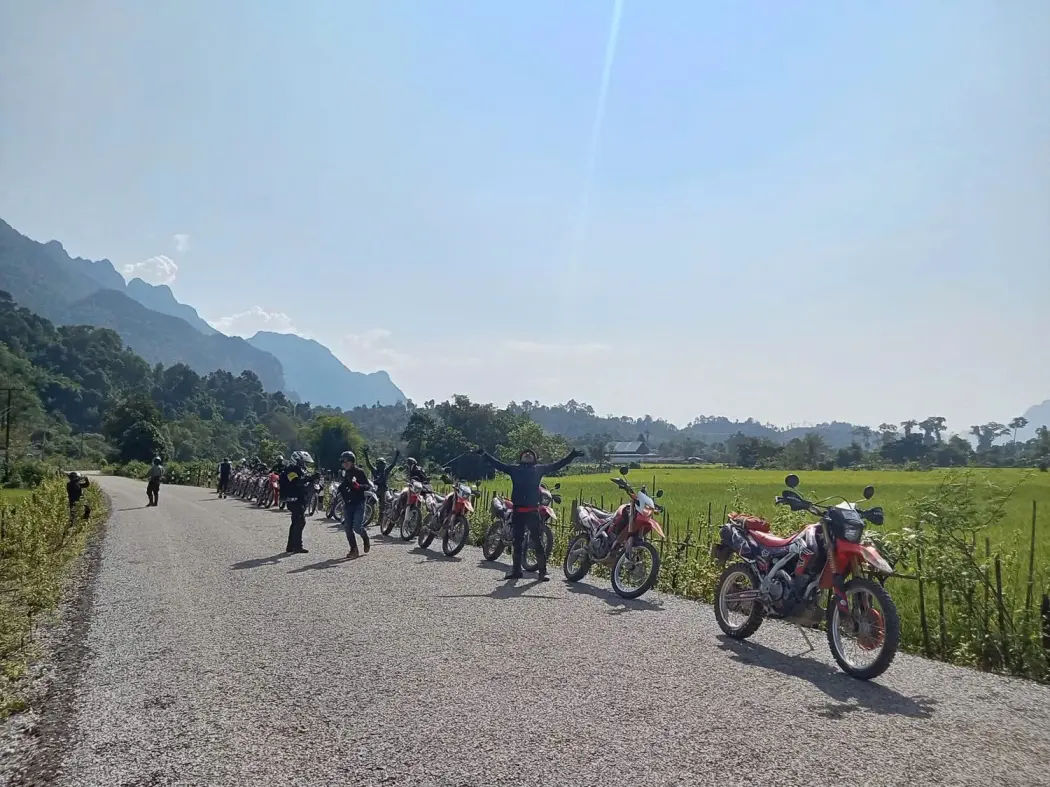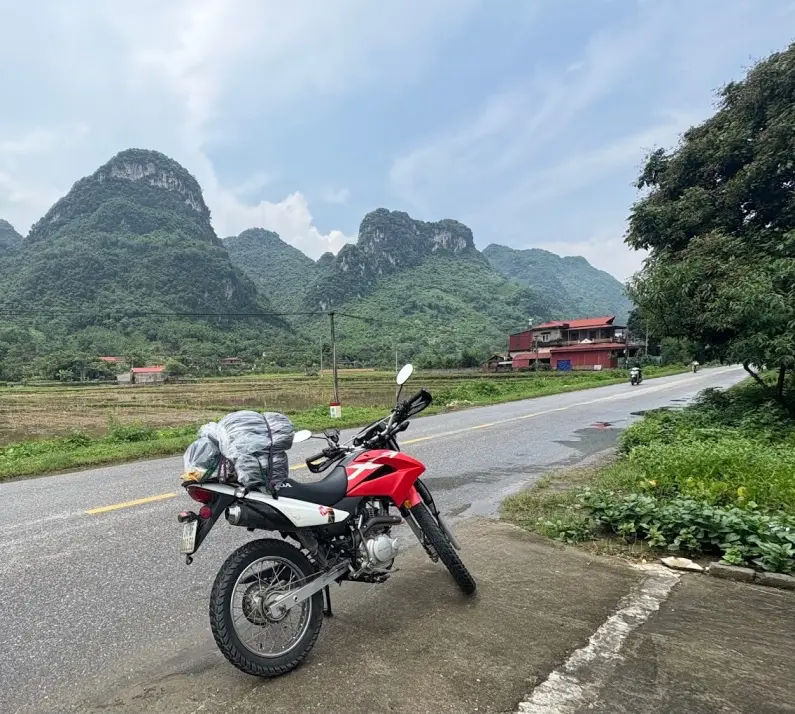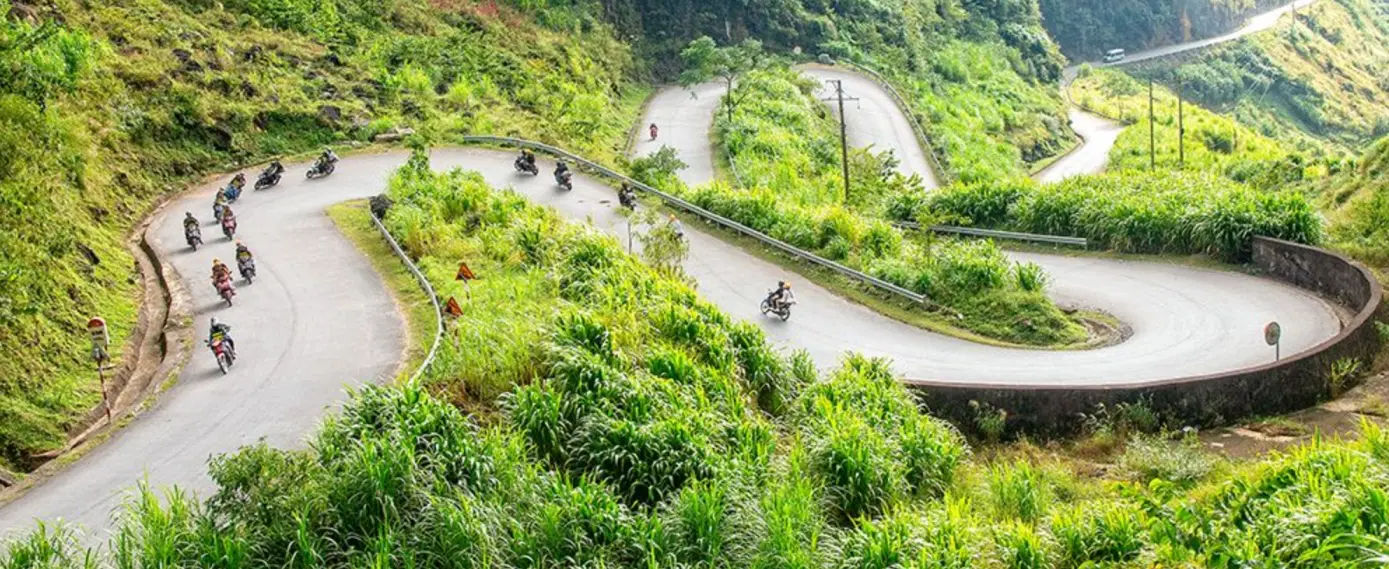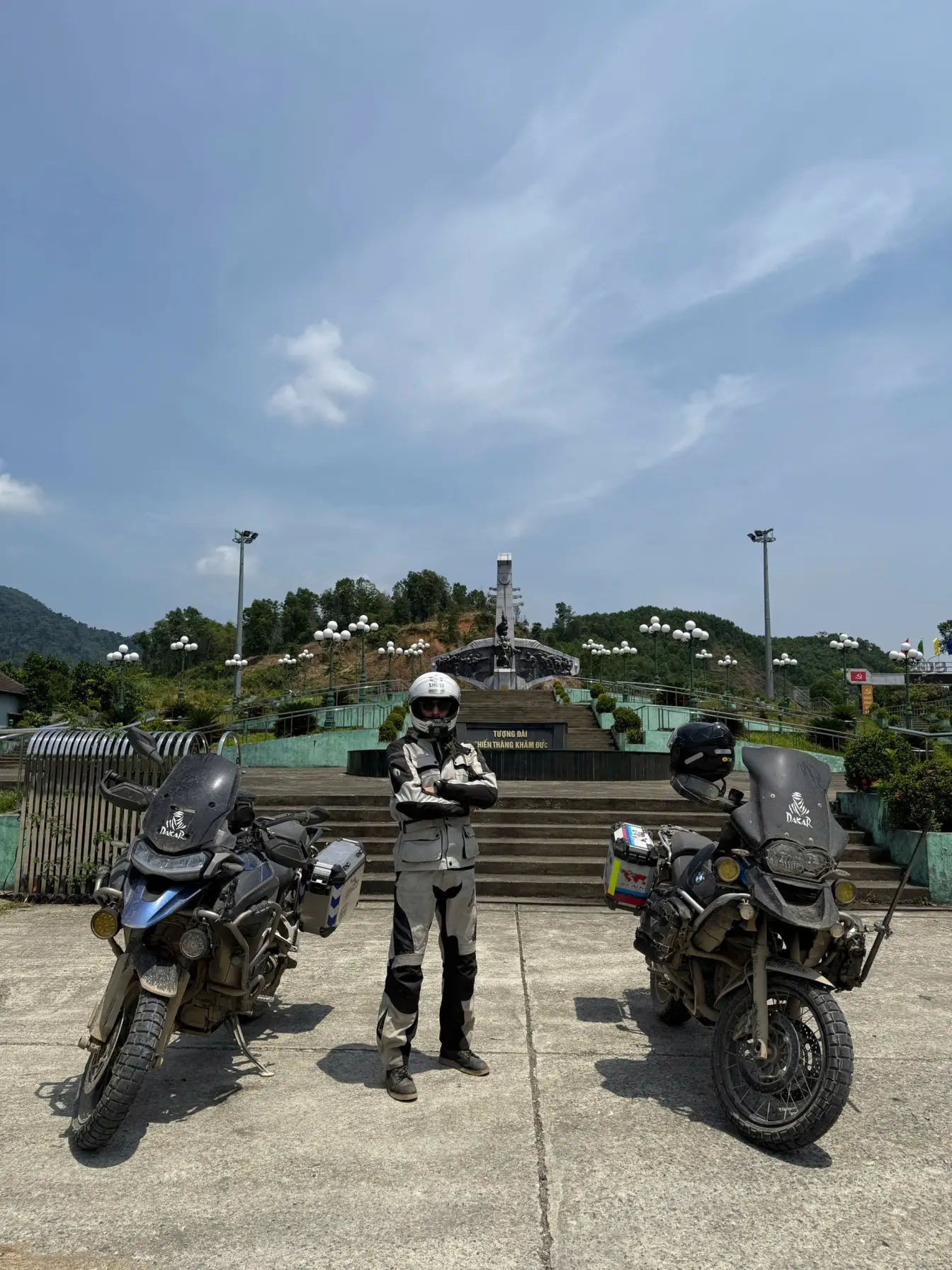
Riding a motorbike in the Dong Van Mountains is one of the most breathtaking experiences you can have in Northern Vietnam. The area, located in Ha Giang Province, offers some of the most dramatic landscapes in Southeast Asia, with towering limestone karsts, high mountain passes, and remote ethnic villages that seem frozen in time.
In the other hand, the narrow cliffside roads that test your focus to peaceful valleys where local markets burst with color, Dong Van motorcycle ride is a journey along the twist and turn brings a new view, a new sound, and a new story waiting to be discovered.
Introduction to Dong Van Motorbike Tours
The rides through the Dong Van Mountains offer an incredible way to discover the wild beauty the region, in fact, the first winding mountain passes, dramatic limestone peaks, and colorful ethnic villages make reveals once entering the routes around the Dong Van.
I can assure that exploring Dong Van by motorbike offers both thrilling adventure and a glimpse into local highland culture, those things not many tourist experience it in the city tours in Vietnam.
To enjoy a safe and memorable ride, it’s important to choose the right route and a trusted organizer. In this guide, I, Hamid from Vietnamese Motorbike Tours, will share my own perspective and guidance for Dong Van with my local tips to make the most of your journey.
Quick Overview of Dong Van Mountains as a Motorbiking Destination
Dong Van is part of the larger Ha Giang Loop, one of Vietnam’s most iconic motorbike routes. The region’s mix of steep mountain roads, traditional Hmong villages, and panoramic viewpoints make it a dream for photographers and adventure riders alike. While the ride can be challenging in parts, it’s also one of the most rewarding routes in all of Vietnam.
The small town is located about 150 kilometers north of Ha Giang City, Dong Van lies deep in the Loop and is known for its rugged mountain scenery and ethnic minority villages.
Route Map: Ha Giang to Dong Van
Why This Route is Perfect for an Adventure?
Simply because riding through the route via Đồng Văn on the Ha Giang Loop is perfect for adventure because the roads sweep through remote mountain passes and dramatic limestone karsts that few travellers get to see, giving you that raw sense of being on the edge of Vietnam: as one rider put it, “fog-covered mountain passes, rice terraces that stretch forever, and the kindest people I’ve ever met.”
You’ll find tight hairpin bends and steep slopes that test your focus, “sharp bends and steep drop-offs”. Yet the payoff is huge: ancient villages, high-altitude views and a chance to move at your own pace, away from the tour crowds, making each turn feel meaningful rather than rushed.
About Dong Van Mountains
This small town is more like an overnight stop for anyone taking the loop rider, it is nestled in the far-north of Vietnam’s Ha Giang Province, the Dong Van region sits within the dramatic limestone terrain of the Dong Van Karst Plateau Geopark where rugged peaks, deep valleys and remote highland villages set the scene.
Here you can explore the lively Sunday market, a swirl of colorful ethnic costumes, fresh produce and brocade textiles.
Staying overnight in Dong Van town makes sense because it offers cosy guesthouses, a charming old quarter and easy access to sunrise views and the starting point of the epic next leg of your journey, the scenic ride over the Ma Pi Leng Pass toward Meo Vac, where the Nho Que River carves through the mountains and the high-altitude terrain opens up even more.
Geography and Terrain Features
The Dong Van Karst Plateau is a UNESCO Global Geopark, covering over 2,300 square kilometers of rugged limestone formations. The terrain is a mix of sharp cliffs, deep valleys, and winding passes that make for both challenging and exhilarating riding. You’ll encounter stone plateaus, cornfields growing on rocky ground, and remote hamlets nestled against steep hillsides.
Climate and Best Seasons for Riding
The best time to ride through Dong Van is from September to November or March to May, when the skies are clear and temperatures mild. Winter (December to February) can get chilly, especially in the mornings, and fog may obscure the views. The rainy season (June to August) brings slippery roads and potential landslides, so it’s not ideal for less experienced riders.
- Check out the best month to go to Ha Giang
Must-Ride Routes in Dong Van
If you’re wondering where to start your ride, here are suggestions on key stops that capture the best of the Dong Van motorcycle ride. Each destination offers something different interns of routes and sceneries, from quiet mountain towns surrounded by rice terraces to limestone peaks that rise above the clouds.
Together, they form the backbone of most Dong Van motorbike tours, giving riders a balanced mix of scenery, culture, and open-road freedom.
- Check out lesser known routes of the Ha Giang Loop
Route 1: Dong Van to Meo Vac
Key Highlights and Viewpoints
This section of the area is famous for its sweeping views of the Nho Que River and towering cliffs. Along the way, you’ll pass small villages, mountain viewpoints, and endless hairpin turns. Stop at the Ma Pi Leng Panorama Viewpoint for one of the most stunning vistas in Vietnam, a dramatic canyon with turquoise waters far below.
Road Conditions and Difficulty Level
The road between Dong Van and Meo Vac (the first leg of the ride) is well-paved but narrow. Expect sharp turns, sudden drops, and occasional buffalo and goats wandering across the path. While it’s suggested to ride it on a manual bikes, beginners should ride cautiously and avoid rainy days when the road can get slick.
Route 2: Ma Pi Leng Pass Adventure
Scenic Mountain Roads
Often called the “King of Passes” in Vietnam, Ma Pi Leng is a bucket-list ride. The road snakes along steep cliffs, offering a dizzying view of limestone peaks and the emerald river below. Each stop is a postcard, with clouds hanging low and sunlight cutting through the mist.
Safety Tips for Challenging Sections
Keep your speed low and your focus high. Avoid overtaking on blind corner as trucks are passing occasionally, and always honk before turns (This is a local way), as locals expect it. It’s wise to start early in the morning to avoid fog, and check your brakes and tire pressure before tackling the descent into Meo Vac.
Route 3: Ride through the Remote Villages
Cultural Experiences in Local Villages
Beyond the main passes, take detours to visit villages like Lo Lo Chai near the Lung Cu Flag Tower, where ethnic Lo Lo and Hmong communities live. You’ll find traditional stilt houses, stone fences, and locals wearing vibrant traditional attire. Many travelers say these cultural stops are the most memorable parts of their journey.
Recommended Stops for Food and Rest
Stop by Dong Van Old Quarter for coffee and local eat, the foods are local cuisines, mainly different kinds of noodle soup and hot pot, which is perfect for colder evenings, additionally, visit Meo Vac Market if your timing matches a Sunday fr more local market activity.
Guesthouses and homestays along the route provide all sort of simple local meals include on their room servicespitality, making your rest stops as special as the ride itself.
Essential Tips for Motorbiking in Dong Van area
Here we share our local knowledge about few of the question asked by the travelers. Fuel stations can be limited in more remote areas and once you leave Ha Giang City, so it’s best to fill up whenever you see one.
Basic guesthouses and homestays in Dong Van or Meo Vac usually cost around 250,000–400,000 VND per person, per night, offering simple but clean rooms. Bring some cash, as ATMs are usually difficult to find and best to not relay on ATM once in Ha Giang and Dong Van, additionally, pack warm clothes since the temperature can drop quickly in the mountains. A raincoat, gloves, and a basic tool kit will also make your ride smoother and safer.
Choosing the Right Motorbike for Mountain Roads
A manual motorbike is ideal for tackling the Dong Van route. Popular choices among riders include the Honda XR150L, Honda XR190L, and Honda CB500X, all reliable bikes with strong performance on steep climbs and rough terrain. Most rental shops in Ha Giang City provide well-maintained models equipped with luggage racks, spare helmets, and basic repair tools for the journey.
- Check out Big motorbike tours
Safety Gear and Protective Equipment
Always wear proper protective gear, a good helmet, gloves, knee and elbow guards, and shoes or best if boots. Most rental companies in Ha Giang provide only basic helmets, so it’s worth buying your own or asking if they have higher-quality options available (even for rent), especially if you expect rain.
Sunglasses and a rain poncho are also must-haves, as the weather can change from bright sunshine to fog or heavy rain within minutes at higher elevations.
Fuel, Accommodation, and Food Planning
Fuel stations are easily found outside of major towns, so refill whenever you can. If you’re planning to ride through the more remote areas, make sure you have enough fuel.
Accommodation options range from basic homestays to small boutique lodges runs by locals in Dong Van. For food, expect local dishes like pho, rice with pork, and corn wine (though save that for after the ride!).
Photography and Scenic Stops
Best Viewpoints for Photography
Don’t miss the Ma Pi Leng Panorama, Lung Cu Flag Tower, and the Tham Ma Pass for breathtaking sunrise and sunset views.
Along the way, stop by small villages such as Lung Cam, Sung La, and Lo Lo Chai, where you can meet Hmong and Lo Lo ethnic families and see their traditional homes.
The winding roads, terraced fields, and ever-changing light over the limestone peaks make this region a dream for photographers and anyone seeking an authentic glimpse of life in Vietnam’s northern highlands.
Hidden Spots Off the Main Roads
Venture slightly off the loop to discover hidden valleys near Xin Cai and Pa Vi. You can reach these villages by taking the small side roads branching off from the main Dong Van, Meo Vac route; the roads are narrow but well worth the ride for their peaceful scenery.
These lesser-known spots offer serene mountain views without the crowds, perfect for a quiet stop, a cup of local tea, or some drone photography. You’ll often pass through terraced fields and meet friendly Hmong families along the way, giving you a glimpse of everyday life in Vietnam’s remote highlands.
Motorbiking in Dong Van Mountains: Travel Recommendations
Dong Van Mountains motorbike ride: Key Takeaways and Travel Tips
“It’s not just about reaching Dong Van, it’s about embracing the entire ride,” I always say that to my riders whenever we take a loop ride from Hanoi.
In reality, you will not feel rushed and I absolutely recommend to drive just a bit further and find equally or more stunning, quiet spots.”
Some tips including ride slow and allow time for unplanned stops, chat with locals respectfully (a smile works wonders in upland villages), and keep your attention on the road, mountain roads require care and focus.
Preparedness is essential: check your bike, keep some cash for remote areas, and always carry a rain jacket and warm layer, the weather can shift in minutes. Ride thoughtfully, stay safe, and you’ll find every stop offers something more than just a view.
Summary of Routes and Experiences
The Dong Van to Meo Vac section offers the best mix of challenge and scenery. Ma Pi Leng Pass is the just another amazing one, while the remote village detours provide a window into authentic northern life. Together, they form a ride that defines Vietnam’s adventurous spirit.
Encouragement to Plan a Safe and Scenic Adventure
If you’re dreaming of an authentic motorbiking adventure, Dong Van Mountains should be at the top of your list. Pack wisely, respect the locals, and enjoy every twist of the road. The mountains are waiting, all you need is the courage to ride them.
Frequently Asked Questions (FA
What is the best time of year to motorbike in Dong Van Mountains?
The best months are March to May and September to November, offering clear skies and dry conditions.
How long does it take to complete the main Dong Van routes?
Most riders spend 3 to 4 days exploring Dong Van, Meo Vac, and surrounding areas as part of the larger Ha Giang Loop.
What type of motorbike is most suitable for mountain roads?
A manual motorbike (125cc–150cc) is recommended for better control on steep and winding roads. most experienced riders opt for anything more than 250cc, the ideal ADV motorcycle is the CB500X.
Are there enough fuel and food stops along the way?
Yes, but fuel stations are pretty much everywhere and you can find them every 10-20km. Always top up when possible, and carry snacks or water for long stretches.
Can beginners safely ride the Dong Van Mountain routes?
Beginners can manage with caution, especially on clear, dry days. However, some sections like Ma Pi Leng Pass require confidence and focus, so practice before attempting the full loop. Check out safety along the Ha Giang loop
About the author
Hamid is an adventure motorbike rider and travel enthusiast who has explored the winding roads and remote villages of Northern Vietnam extensively. Passionate about discovering off-the-beaten-path destinations, Ham shares practical tips and firsthand experiences for fellow riders and travelers. Learn more about the Dong Van region on the official local commune website.




